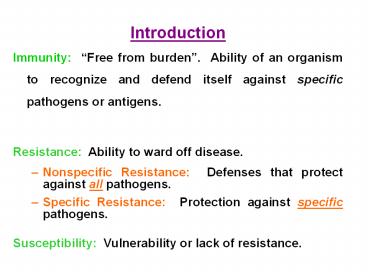Immunity: PowerPoint PPT Presentation
Title: Immunity:
1
- Introduction
- Immunity Free from burden. Ability of an
organism to recognize and defend itself against
specific pathogens or antigens. - Resistance Ability to ward off disease.
- Nonspecific Resistance Defenses that protect
against all pathogens. - Specific Resistance Protection against specific
pathogens. - Susceptibility Vulnerability or lack of
resistance.
2
- Protection Against Invading Pathogens
- 1. First Line of Defense Non-specific natural
barriers which restrict entry of pathogen. - Examples Skin and mucous membranes.
- 2. Second Line of Defense Innate non-specific
immune defenses provide rapid local response to
pathogen after it has entered host. - Examples phagocytes(macrophages and
neutrophils), inflammation, and interferon. - 3. Third line of defense Antigen-specific
immune responses, specifically target and attack
invaders that get past first two lines of
defense. - Examples Antibodies and lymphocytes.
3
Three Lines of Defense Against Infection
4
- First Line of Defense
- Skin and Mucous Membranes
- I. Mechanical Defenses
- 1. Skin has two Layers
- A. Epidermis Thin outer layer of epithelial
tissue. - Contains Langerhans cells, dead cells, and
keratin (waterproof). - B. Dermis Thick inner layer of connective
tissue. - Infections are rare in intact skin. Exceptions
- Hookworms can penetrate intact skin
- Dermatophytes Skin loving fungi
5
Intact Skin is an Effective Barrier Against Most
Pathogens
6
(No Transcript)
7
- I. Mechanical Defenses
- 2. Mucous Membranes Line gastrointestinal,
genitourinary, and respiratory tracts. - Two layers Outer epithelial and inner connective
layer. - Epithelial layer secretes mucus which maintains
moist surfaces. - Although they inhibit microbial entry, they offer
less protection than skin. - Several microorganisms are capable of penetrating
mucous membranes - Papillomavirus , Treponema pallidum ,
Enteroinvasive E. coli - Entamoeba histolytica
8
- I. Mechanical Defenses
- 3. Lacrimal apparatus Continual washing and
blinking prevents microbes from settling on the
eye surface. - 4. Saliva Washes microbes from teeth and mouth
mucous membranes. - 5. Mucus Thick secretion that traps many
microbes. - 6. Nose Hair Coated with mucus filter dust,
pollen, and microbes. - 7. Ciliary Escalator Cilia on mucous membranes
of lower respiratory tract move upwards towards
throat at 1-3 cm/hour.
9
- I. Mechanical Defenses
- 8. Coughing and sneezing Expel foreign objects.
- 9. Epiglottis Covers larynx during swallowing.
- 10. Urination Cleanses urethra.
- 11. Vaginal Secretions Remove microbes from
genital tract.
10
Epiglottis Protects Respiratory System from
Infection During Swallowing
11
- B. Chemical Defenses
- Sebum Oily substance produced by sebaceous
glands that forms a protective layer over skin.
Contains unsaturated fatty acids which inhibit
growth of certain pathogenic bacteria and fungi. - pH Low, skin pH usually between 3 and 5.
Caused by lactic acid and fatty acids. - Perspiration Produced by sweat glands.
Contains lysozyme and acids. - Lysozyme Enzyme that breaks down gram-positive
cell walls. Found in nasal secretions, saliva,
and tears.
12
- B. Chemical Defenses
- Gastric Juice Mixture of hydrochloric acid,
enzymes, and mucus. pH between 1.2 to 3 kills
many microbes and destroys most toxins. Many
enteric bacteria are protected by food particles.
- Helicobacter pylori neutralizes stomach
acid and can grow in the stomach, causing
gastritis and ulcers. - 6. Transferrins Iron-binding proteins in blood
which inhibit bacterial growth by reducing
available iron.
13
- Cellular Elements of Blood
- Cell Type Cells/mm3
Function - Erythrocytes (RBC) 4.8-5.4 million
Transport O2 and CO2 - Leukocytes (WBC) 5000-9000 Various
- A. Granulocytes
- 1. Neutrophils (70 of WBC) Phagocytosis
- 2. Basophils (1) Produce histamine
- 3. Eosinophils (4) Toxins against
parasites some phagocytosis - B. Monocytes/Macrophages (5) Phagocytosis
- C. Lymphocytes (20) Antibody production
(B cells) - Cell mediated immunity (T cells)
- Platelets 300,000 Blood clotting
14
- II. Second Line of Defense
- 1. Phagocytosis
- Derived from the Greek words Eat and cell.
- Phagocytosis is carried out by white blood cells
macrophages, neutrophils, and occasionally
eosinophils. - Neutrophils predominate early in infection.
- Wandering macrophagesOriginate from monocytes
that leave blood and enter infected tissue, and
develop into phagocytic cells. - Fixed Macrophages (Histiocytes) Located in
liver, nervous system, lungs, lymph nodes, bone
marrow, and several other tissues.
15
Phagocytic Cells Macrophages (Monocytes),
Neutrophils, and Eosinophils
(Macrophages)
16
(No Transcript)
17
(No Transcript)
18
(No Transcript)

